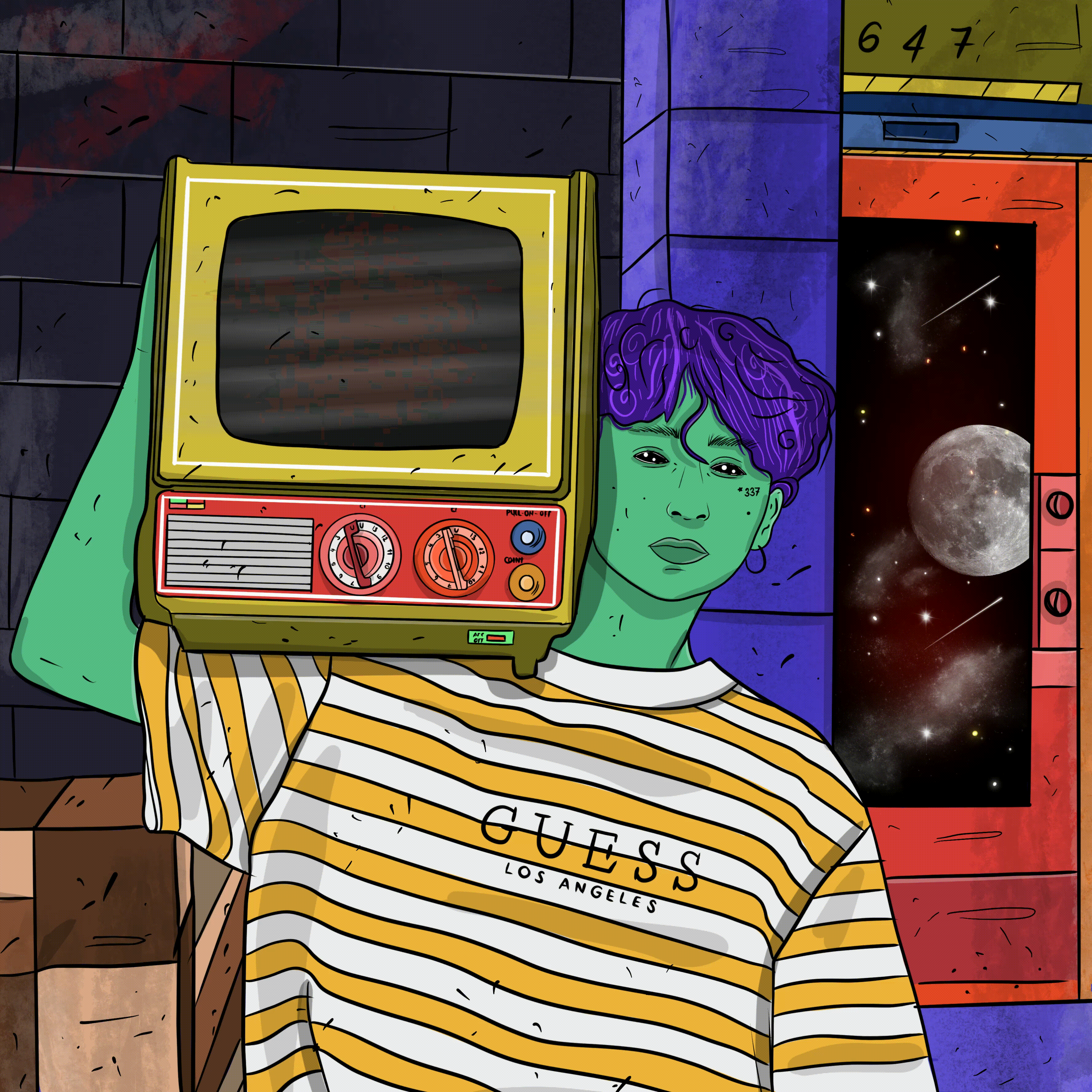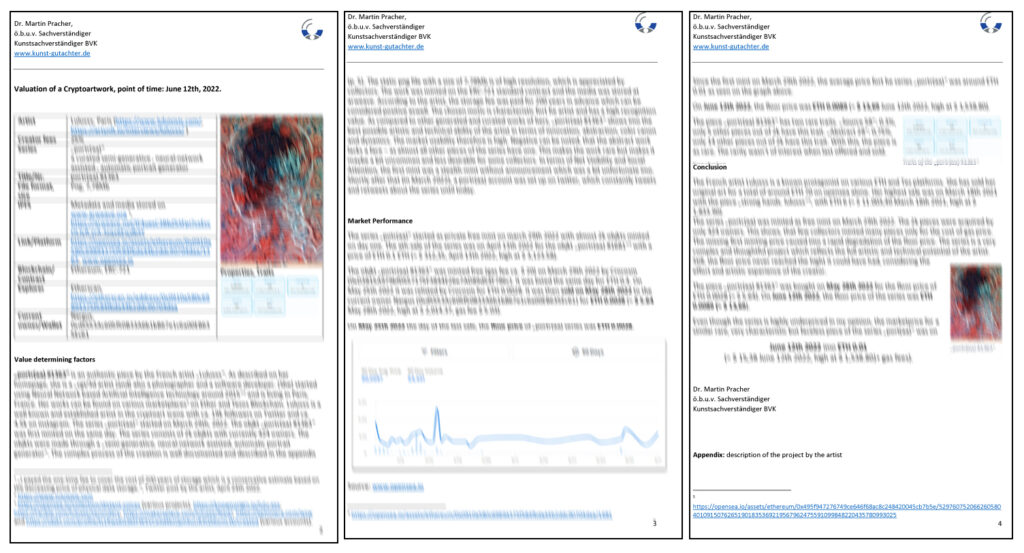NFT Valuation
Dr. Martin Pracher is a German publicly appointed and sworn expert witness, appraiser, lecturer and art- and cryptoart collector. He offers impartial and neutral determination of the common value, insurance value and fair market value of NFTs / Cryptoart and Cryptoart collections for taxation purposes, court cases, insurance companies and private collectors.
Non Fungible Token
Non Fungible Tokens have become a serious asset in the art world. They are digital files like images, short animated gifs or videos that are linked to a blockchain-based, unchangeable data set (artwork further only referred to as NFT). The technical process by which an NFT is tied to a digital file is called “minting”. This immutability of the token means that they can be traded, bought and sold. There are singular works of art tokenized, but also edition works.
Link⇒: NFT Cryptoart in the Bottler + Pracher Collection
Viewer and owner
Unlike traditional artworks, the original artwork can be viewed, shared, distributed and downloaded. The distribution is even welcomed, since a higher popularity can increase the value. With this, the artwork is available to all, but the actual owner is only one person, the verifiable buyer (or the artist). An interesting characteristic of the NFTs is that the artist or creator receives a certain percentage of the trade proceeds every time his work is sold again. In addition to the primary market, i.e. direct sales by the artist/creator, there is thus a secondary market on which works that have already been traded are sold.
NFT Exchange platforms
NFTs are issued and traded on exchange platforms such as www.rarible.com, www.foundation.app, www.superrare.co, www.opensea.io or www.hicetnunc.art. In in-time-based auctions, bids are placed or instant prices are accepted. Purchases are mostly made with cryptocurrencies such as ETH (Ethereum) or XTZ (Tezos), depending on the blockchain, the token is embedded in. Due to the strong fluctuations in the crypto currencies, the value of the requested price(!) also fluctuates. Both collectors and artists are present on these exchanges with their own profiles. The created and traded artworks are shown on the profiles. Thus, it can be traced for each work of art who the artist and the current owner is, when it was traded and even who(!) placed bids in an auction. On the one hand, this creates a transparent traceability and provenance, but on the other hand, a lack of transparency, since only profile names are used, not real names. Who the real artist, bidder and buyer is, remains in the dark.
Value-determining factors for NFTs?

NFT-based cryptoartworks are, like any asset, subject to the law of supply and demand. The question, however, is how an evaluation of the significance of the artist, his work and a potential market reaction can be practically implemented.
If one looks at the traditional “value-determining factors”
authenticity, artist, school, signature and dating, genre, technique, dimensions, motif, innovation, condition, market freshness, art- and cultural-historical significance, quality, provenance, freedom from restitution, rarity, creative period, characteristics, temporary attention and performance
it quickly becomes clear that these can only be applied to NFTs to a limited extent, that the weighting shifts significantly and that additions become necessary.
New weighting of the value-determining factors for NFTs.

The “authenticity” plays a decisive role, since also copied or stolen works can be “minted”. The criterion “school” can rather be reworded as “collective” at this point in time. A “signature” is obsolete, as it is replaced by the digital signature, “genre” plays a subordinate role in pricing, the criterion “technology”, i.e. a technical excellence through clean* manufacturing as well as a high resolution, is perceived and rewarded by the market *(the term “Clean NFTs” refers to energy-saving NFTs on the Tezos blockchain), “dimension” could be translated to “resolution”, “condition” now refers to the ongoing stability, security, and accessibility of the decentralized and off-chain storage and could be referred as “NFT storage condition”, “motif” and “innovation” gain relevance, “market freshness” is rather less relevant, for the attention a work received up front appears to be crucial for its monetary success, “art- and cultural-historical meanings” have to be redefined according to the prevailing net-culture, traditional artistic “quality” loses weight due to lack of comparability, which means the quality of NFTs can only be assessed on the basis of NFTs, complete “provenance” is given by the Non Fungible data set, “rarity” gains significantly in importance in connection with prominence, for the criterion of the “creative period” (e. g. the “furious late work”) it is still too early, “characteristic” and “recognition value” as means of an artistic style, are rather less important but applied to the motif, very important, due to the inhomogeneity of the art trend and, of course, the direct digital connection to the artist, the “temporary attention” becomes imo the decisive value-determining factor as “visibility on the net” and “social attention”, the “market performance” is shaped by the NFT exchange platforms as trading channels and by the large fluctuations of cryptocurrencies.
Supplementing the value-determining factors for NFTs
In my opinion, the following four points must be taken into account to supplement the value-determining factors for NFTs in practice:
The NFT market
Even though the major auction houses already trade NFTs, the exchange platforms mentioned are the actual trading centers. Due to the price and trading provenance, these offer a large amount of data as a basis for a valuation. To be taken into account are short-term significant fluctuations in the value of historical trading prices, the associated net events of the historical trading and short-term hypes.
The collectors

So welcome home..:)”, 2021, X/15, Gif, b+b Cryptoart Collection.
At first, NFTs appeald to a younger collector group of digital natives, respectively crypto natives, whose aesthetic understanding had been shaped by computer graphics, animation and memes. The critical examination of NFTs of this “net aesthetic” can only be based on comparable NFTs. Traditional imagery notion can’t be applied. It must also be taken into account that the boundary between artist and collector is disappearing. The motives of a purchase can certainly play a role in the formation of the price.
The monetary currency
Cryptocurrencies are currently still subject to large fluctuations. Large currency fluctuations lead to high profits, which are then invested generously and sometimes unreflectively in cryptoart.
The social currency
In my opinion, the current and potential value of an NFT is largely generated by its visibility on the net and by social attention. The better known a motif or meme is, and meanwhile also an artist, but also the more innovative the presentation, the more coveted the work is. Through social media channels, this social attention can be steered. With the presence of artists, collectors, and especially their collections on the exchange platforms, visibility, social relevance and desirability are in turn generated.
Value-determining factors for NFTs!
Accordingly, I therefore propose the following changes and additions to the value-determining factors for the valuation of NFTs:
Authenticity, Artist, Collective, Dating, Technique, Resolution, NFT storage condition, Motif, Innovation, Art- and Cultural-Historical Significance, Quality (NFT to NFT), Net-Aesthetics, Provenance, Scarcity, Collector, Net Visibility, Social Attention, and Market Performance.
By considering and analyzing the value-determining factors for NFTs, various aspects of the digital work of art are highlighted, which together lead to a better understanding of art and artist on the market at a defined point in time – and possibly allow predictions about the further development.
Dr. Martin Pracher, 04/15/2021
www.crypto-artprice.com



